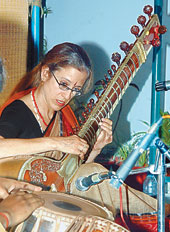 |
| Amelia in performance at Srijan. Picture by Sanjoy Chattopadhyaya |
The first thing that strikes one about Amelia Maciszewski is her warmth, exuded through her smile and her infectious laughter. But when she sits with her sitar, it is her honesty that rings the loudest.
The horns of buses speeding by, the crackle of the microphone, or the long interface that she had to take part in immediately before her performance could have been excuses enough for concentration faltering during the alaap (of raag shyamkalyan). But Amelia would have none of that. Even as listeners at the Srijan rooftop come forward to congratulate her for what ended as a wonderful recital, she keeps reminding herself and others that it should have started better.
But ask the 51-year-old about her choice of vocation ? ethnomusicologist and sitarist ? and all traces of regret vanish from the voice.
It is a difficult question if Amelia would have made the trip to India as a student if jazz was included in the syllabus back home in New Mexico, but there she was in 1977, thinking of ?dabbling? in music of the land. ?I had heard Indian instruments in Beatles songs like Sergeant Pepper and later in an album called Wonder World I had picked up in Colorado.? That was where she heard her guru Ustad Aashish Khan, 20 years before they met.
The push from ?preconscious? to the conscious came on hearing the tuning of an instrument in a little shop in Benaras.
Strangely, it was in Santiniketan that she landed, while being completely dismissive of Rabindrasangeet. (?Boro nyaka, nyaka. Bhalo lage na.?) After seven years and two degrees in sitar at Tagore?s school, Amelia returned to Texas for research on women in Hindustani music.
The concern has been making her spread herself. To singing, for one. ?I was always discouraged from taking vocal lessons as I was a foreigner.? But research made her understand the need for it. ?Moreover, instruments belong to a male-dominated world. I wanted to learn from a woman.? At last, she landed at Girija Devi?s door. ?She told me, ?Arey beta, tum baat kar leti ho to gana kyun nahin hoga?? and set me two months of sargam practice.?
Today, Amelia finds it hard to decide where she finds greater fulfilment ? in her voice or in her fingers. ?Perhaps I am more at ease with the sitar since I learnt that first,? she resolves.
Being a performer makes her understand how incomplete research is on paper. That has taken her behind the camera ? and to kothis of about 20 tawaifs in Muzaffarpur, Jaunpur, Delhi, Benaras and Calcutta (there are still a couple of courtyards in Bowbazar).
Being trained to please listeners, the baijis are good raconteurs, she points out. Is the baiji culture on its deathbed? ?With customers lacking musical taste, it is taking a sleazy route.?
The most poignant moment of her meetings was one with Kalidasi Bai of Muzaffarpur, who sings in the Benarasi gharana. ?The octogenarian lady took one look at me and said: ?Suno beta, mar gaya hain nawab saheb. Ab sab ki kahani ek jaisi hogi. (Listen child, the patron is dead. Now everyone?s story is the same).? ?
That may sum up the story of a way of life fast being sucked into the sands of time. But her film Guriya, likely to be screened at the Centre for Social Sciences soon, will stand testimony to what posterity may well consider the most crucial offshoot of Amelia?s association with India.










